From Pastoral Reverie to Planetary Grief—How Literature Listens When Nature Speaks
From The Professor's Desk
The Roots Beneath the Text
Literary criticism, for centuries, has walked through drawing rooms, courtrooms, battlefields, and broken hearts—but seldom through forests. While love, power, identity, and rebellion have commanded the interpretive spotlight, the rustling of leaves, the groan of glaciers, and the silence of extinct species often passed unnoticed beneath the prose. Until, that is, literature itself began to gasp—not for metaphors, but for air.
Enter Ecocriticism—a school of literary theory that reads the environment not as setting but as subject, and nature not as passive backdrop but as narrative participant. It asks questions the canon long neglected: What does it mean to speak for the earth? How do texts shape our ecological imaginations? Can literature help us unlearn our dominance?
Of course, nature was always present. Poets from the very beginning have reached for it to express the inexpressible. When Marlowe’s Passionate Shepherd invites his beloved to “Come live with me and be my love,” he doesn’t offer gold or glory—he offers beds of roses, flocks of sheep, and “a cap of flowers, and a kirtle / Embroider’d all with leaves of myrtle.” Nature is currency, courtship, and comfort. The Nymph’s reply, skeptical and autumnal, still speaks through the same pastoral palette.
“Time drives the flocks from field to fold,
When rivers rage and rocks grow cold.”
In Shakespeare’s King Lear, the storm on the heath is not mere atmosphere—it is inner anguish turned meteorological. The blasted winds mirror Lear’s disintegrating mind and crumbling kingdom. The natural world does not just echo human pain—it embodies it.
As Cheryll Glotfelty, one of the founding voices of Ecocriticism, declared:
“Ecocriticism is the study of the relationship between literature and the physical environment.”
This deceptively simple line cracks open centuries of anthropocentric reading. Ecocriticism does not merely interpret texts—it interrogates our place in the world through them. It reads the tree as testimony, the sky as speaker, the sea as a site of resistance.
The forest has always been speaking.
We just didn’t think it had syntax.
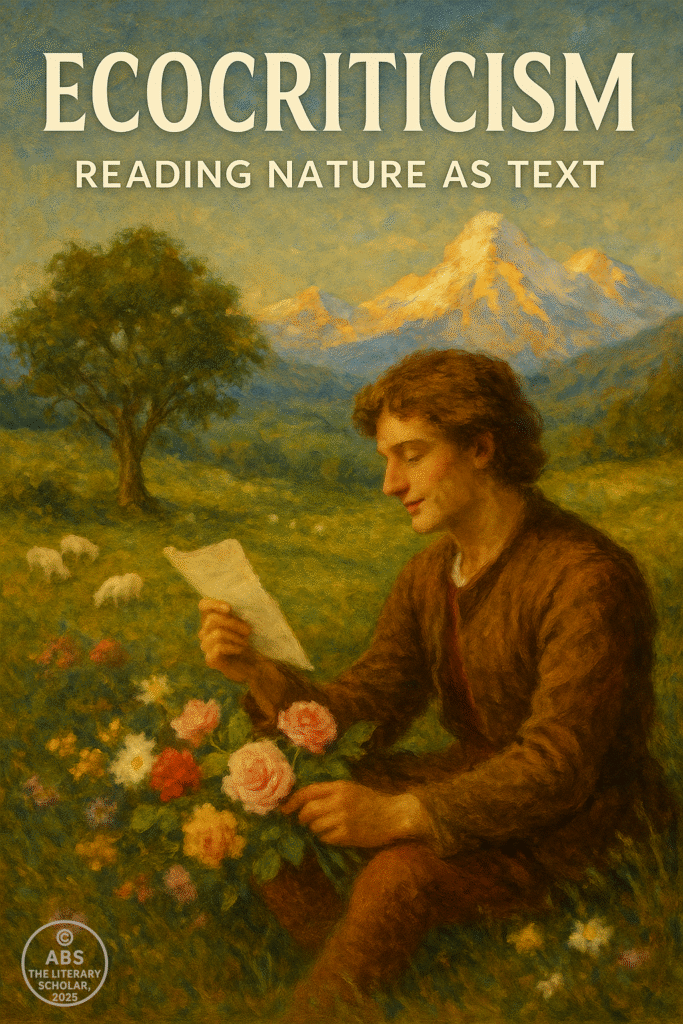
1. “Nature Never Signed a Publishing Contract: What Is Ecocriticism?”
In the long history of literary criticism, we have listened to Hamlet’s soliloquies, unraveled feminist rewritings of fairy tales, decoded the psyche of modernist narrators, and even deconstructed the footnotes. But only recently have we begun to ask: what about the trees?
Not metaphorical trees. Not trees as symbols of love, life, or loss. Just… trees. Bark. Soil. Storms. Tides. The earth as earth.
And that is precisely where Ecocriticism enters the academic conversation—not as a decorative flourish, but as a seismic shift.
The term Ecocriticism emerged in the late 20th century when scholars began to notice that the environment had long been a mute background actor in literature, rarely treated as a living, political, ethical, or narrative subject. It was Cheryll Glotfelty who first formally defined the term in her introduction to The Ecocriticism Reader (1996).
At first glance, the field might seem like an obvious, even quaint idea. After all, nature has always been part of literary landscapes—think of the Romantic poets swooning over mountains, or pastoral odes where shepherds debate metaphysics in meadows. But Glotfelty’s framing is more radical: it calls for an earth-centered approach that repositions the natural world from poetic ornament to central participant in meaning-making.
A Shift from Anthropocentrism to Ecocentrism
Ecocriticism is not simply about counting trees in texts. It is a response to centuries of anthropocentric criticism—interpretations that place human concerns, cultures, and consciousness at the center, treating the rest of the planet as passive setting or metaphor.
Where traditional literary theory asks, What does this say about society, gender, race, or the psyche?
Ecocriticism asks:
What does this say about our relationship with the land?
What ethical obligations does this story suggest toward nature?
How do texts shape our ecological imagination—or lack thereof?
Lawrence Buell, another foundational figure in the field, emphasized that environmental literature must not only foreground nature, but also promote an ethical stance toward it. In his landmark work The Environmental Imagination, Buell wrote:
“Environmental crisis is fundamentally a crisis of the imagination.”
This marks a profound reversal: nature is not backdrop—it is character. It has agency. It transforms. It speaks.
Reading Nature as Text
This shift in critical stance leads to a foundational methodology: reading nature as text. The idea borrows from the hermeneutic traditions of literary theory but applies them to the earth itself. Just as we once parsed stanzas and symbols, we are now being invited to “read” landscapes, animal silences, ruined ecosystems, and climactic extremes.
It’s not merely about what literature says about nature—but how it says it, and what it hides. Does the poem frame the forest as mysterious or maternal? Does the novel treat industrial progress as inevitable or invasive? Does the text reflect ecological humility, or colonial conquest of land?
Take for instance the difference between Wordsworth’s reverent return to nature in Tintern Abbey and Joseph Conrad’s haunting portrayal of the jungle in Heart of Darkness. One whispers in awe; the other trembles in fear.
Both are landscapes. But both are also ideologies wearing moss.
“To regard nature as text is not to reduce it, but to listen differently.”
— Field notes from the new critic’s trail
The Re-Reading of the Literary Canon
Once Ecocriticism in literature entered the frame, the canon itself changed under our gaze. Familiar texts began to pulse with new meaning. Shakespeare’s storm in King Lear became not just a reflection of internal collapse but a moment of ecological fury. Melville’s Moby Dick could be seen not merely as man vs. whale, but as an allegory of industrial arrogance against the wild.
Even the Romantics—long held as lovers of nature—appear more complex under the ecological lens. Was their nature truly wild and autonomous, or was it a mirror for personal transcendence?
Likewise, colonial literatures, once read for their geopolitics, began to reveal ecological imperialism: land mapped, named, tamed. Texts such as Rudyard Kipling’s or travel narratives of the empire often speak the language of domination—not just over people, but over places.
Ecocriticism, then, is not a genre. It is a lens. A politics. A poetics.
It invites a new kind of attentiveness—a kind that sees the mountain not just as metaphor, but as material; not just as aesthetic object, but as threatened being.
Why Now?
We live in an age where headlines often sound like dystopian fiction. Floods. Fires. Heatwaves. Mass extinctions. Climate refugees. Oil spills. Microplastics in poetry.
To read literature now without an environmental consciousness is to miss the ground it stands on.
Ecocriticism is no longer a niche concern—it is a necessary evolution of our interpretive habits. It teaches us that stories shape not just our minds, but our material world. If we read the earth as text, we might finally learn to stop editing it.
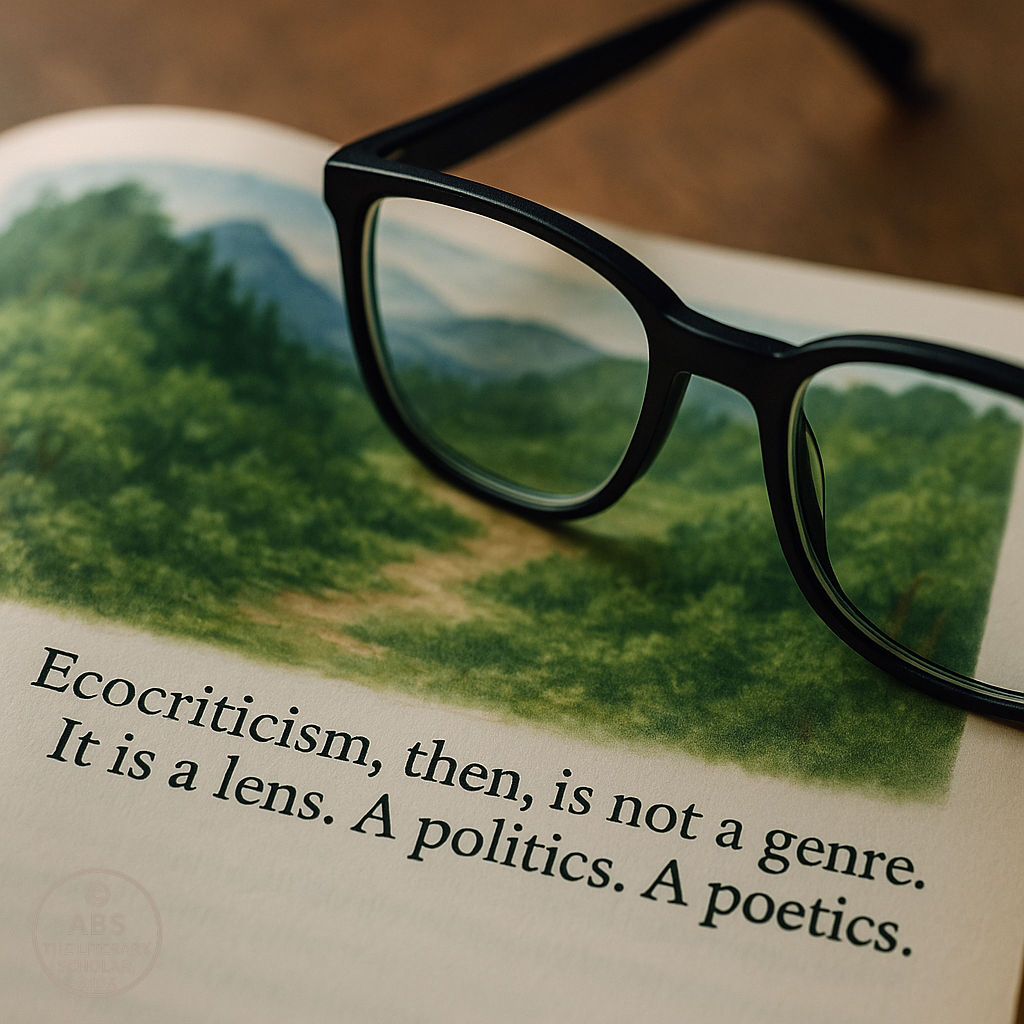
2. Green Readings: How Nature Speaks in Literature
If ecocriticism in literature invites us to read nature as text, then the next question is: how does nature speak—and when is it silenced?
Across the literary canon, nature has played many roles: sacred guide, indifferent witness, lyrical metaphor, colonial trophy, ecological casualty. But rarely has it spoken for itself. What we hear of the earth in literature is often a projection of human desire—filtered, aestheticized, made safe.
Yet, if one listens carefully, one can still hear the voice of the river, the tremor in the mountain, or the warning in the wind.
Wordsworth: The Romantic Oracle of the Earth
Let us begin where ecocritical readings often do—with the Romantic poets, and especially William Wordsworth. In his hands, nature is no longer just background—it is a moral tutor, a source of emotional recovery, and often the only character worth trusting.
In Tintern Abbey, nature restores what civilization corrodes: memory, humility, spiritual clarity. The hills and rivers are not just scenic—they are sentient repositories of wisdom.
But by The World is Too Much With Us, that communion is ruptured:
“The world is too much with us; late and soon,
Getting and spending, we lay waste our powers.”
It is a devastating ecological lament, where nature isn’t destroyed yet—but ignored, dismissed, severed from the human heart.
This is where ecocriticism sharpens its blade: not all nature writing is environmental, and not all pastoral is praise.
Thoreau: The Politics of the Pond
If Wordsworth gave English poetry its green soul, Henry David Thoreau gave American literature its wilderness ethic.
In Walden, the pond is not just a setting—it is a metaphor for self-reliance, simplicity, resistance to capitalism, and spiritual awakening. But it is also literal, studied and described in painstaking detail. Thoreau listens to the frogs. He catalogues the ice.
Ecocriticism regards this not as quaint naturalism but a form of ecological activism—language resisting industrial dehumanization through an embrace of unmanipulated landscapes. When he writes, “I went to the woods because I wished to live deliberately,” we are reminded that living “deliberately” means living with awareness of one’s ecological footprint.
Yet, even here, the human is central. Walden is not the pond’s memoir—it’s Thoreau’s.
Hopkins: Nature as Divine Energy
No one hears nature sing quite like Gerard Manley Hopkins, who doesn’t merely observe nature—he lets it leap linguistically across the page.
In poems like Pied Beauty or God’s Grandeur, Hopkins turns the poet into a naturalist-priest, praising dappled things, falcon flight, and the grandeur of divine ecology. His invented words—“shook foil,” “brute beauty,” “ah! bright wings”—attempt to capture nature’s energy before it disappears into modernity.
Yet even as he praises, he fears. In God’s Grandeur he mourns what man has wrought:
“Generations have trod, have trod, have trod;
And all is seared with trade; bleared, smeared with toil…”
The industrial world mars the divine creation. Here, the pastoral is under siege, and the earth bears the scars of commerce.
Silko and Ghosh: Nature as Ancestral Witness and Global Victim
From the canon to the contemporary, ecocriticism now turns to voices that were once marginalized in literary discourse—Indigenous, postcolonial, feminist, climate-aware.
In Leslie Marmon Silko’s Ceremony, nature is not a metaphor—it is memory, medicine, and map. The land holds ancestral knowledge, and ecological harm is spiritual disintegration. The protagonist, Tayo, cannot heal unless the land heals. This is no romantic walk in the woods—it is trauma recovery through ecological repair.
In a different register, Amitav Ghosh’s The Hungry Tide situates its narrative in the Sundarbans—where tigers, tides, myths, and mangroves all demand their voice. Ghosh gives the nonhuman world dramatic presence. The river does not just reflect emotion—it acts, floods, kills, reshapes. The tide country is not a metaphor—it is a geopolitical, cultural, and ecological force.
Ecocriticism reads The Hungry Tide as a confrontation between scientific rationality and local ecological intelligence, where the native fisherman knows what climate models do not: that the earth remembers.
“Silenced by science, ignored by empire, and buried under metaphor—nature re-emerges in literature as its oldest speaker.”
— Green Readings Notebook, Margins
Pastoral vs. Industrial: A Strained Dialogue
Throughout literary history, pastoral literature—those golden fields of harmony and sheep—has offered an idealized version of nature. But ecocriticism is skeptical of these soft-focus scenes. Why? Because the pastoral often hides politics.
Behind the serenity of shepherd songs lie displaced peasants, conquered lands, and laboring bodies. Behind Wordsworth’s daffodils lie the enclosure acts. Behind pastoral charm may stand ecological erasure.
The industrial, in contrast, appears as the villain—smoke stacks, “dark Satanic mills,” and sooty skies. But ecocriticism resists such binaries. It is not enough to curse machines and romanticize rivers. The real task is to recognize how literature reflects, critiques, and sometimes colludes with environmental change.
The question is no longer: Does this work celebrate nature?
The question now is: What kind of relationship does it construct with the natural world—and who is allowed to speak within it?
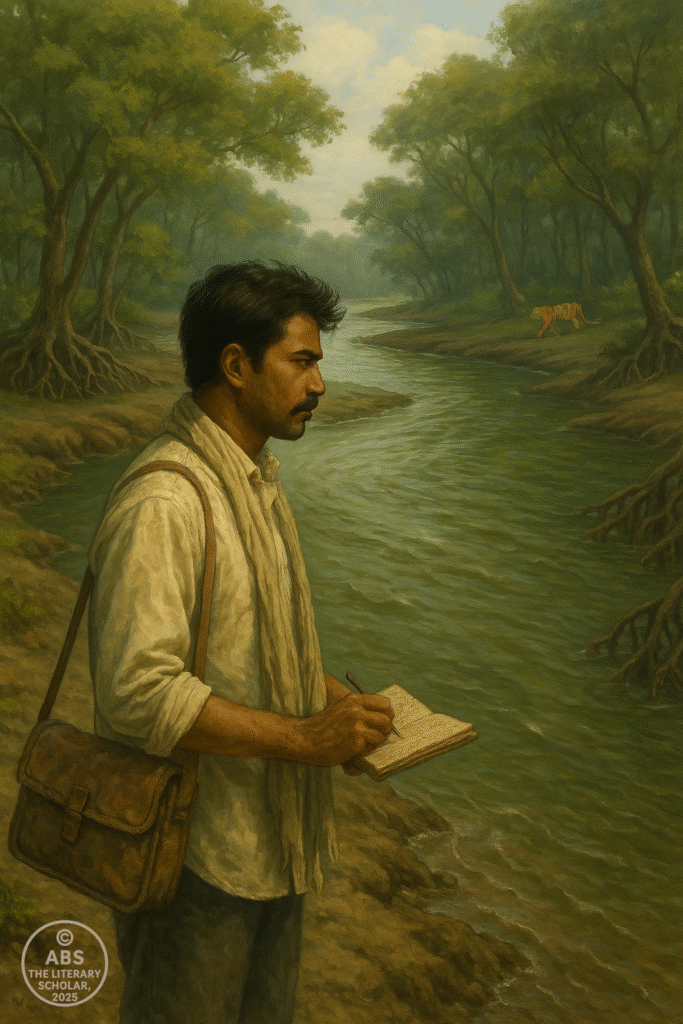
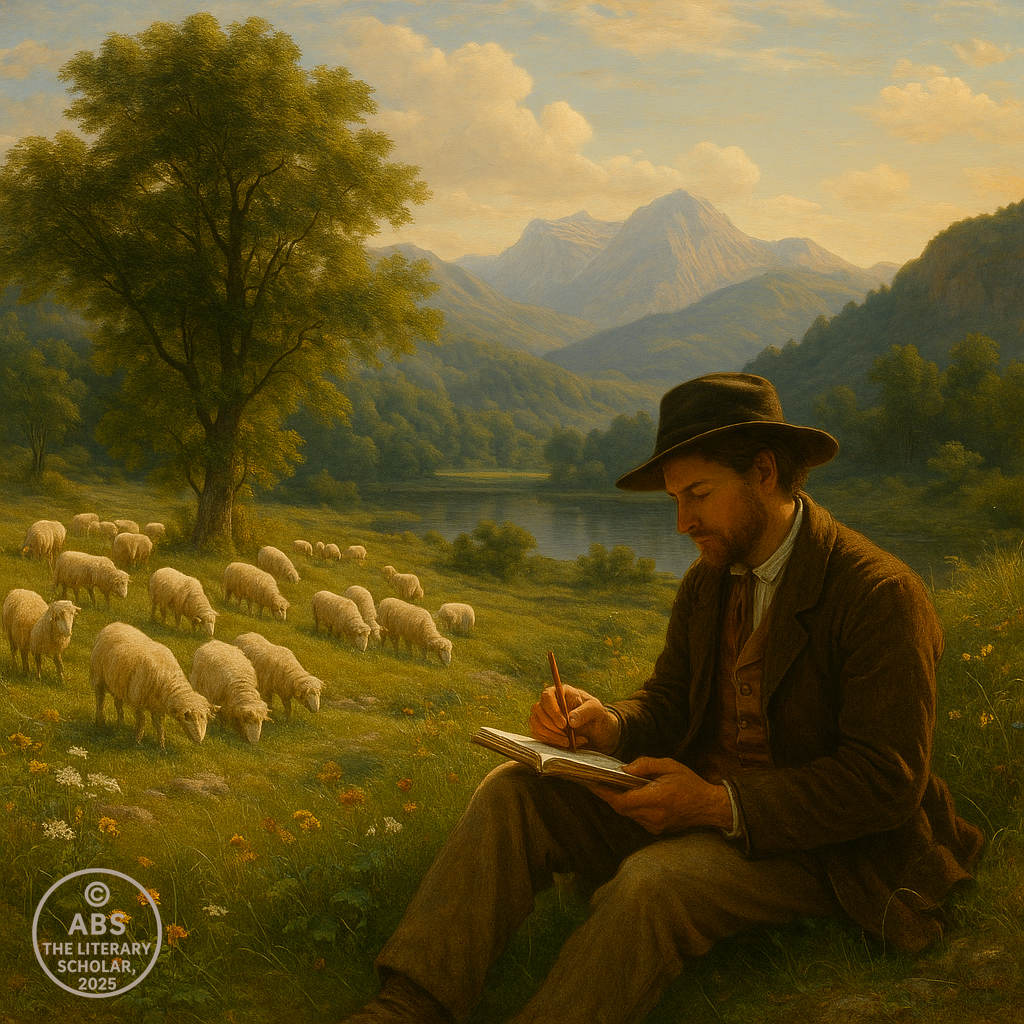
3. Eco-Consciousness and the Future of Literary Studies
If literature has always mirrored human consciousness, the 21st century demands that it now reflect something broader, deeper, and more urgent: eco-consciousness. This is not merely a thematic shift—it is a paradigmatic one, compelling us to ask how literature participates in the planetary crisis of our time. From colonial land theft to rising sea levels, from gendered environmental burdens to speculative climate dystopias—literature is not just watching. It is, increasingly, responding.
The future of literary studies, then, must extend its gaze beyond the page—to the soil, the storm, and the silence.
Postcolonial Ecocriticism: Landscapes of Exploitation
Traditional ecocriticism, born in the American academy, often focused on wilderness preservation, pastoral idealism, or Romantic reverence. But postcolonial ecocriticism tells a different story—one of land as commodity, colony, and conflict. Here, the environment is not simply sacred—it is stolen.
Ramachandra Guha, a foundational voice in this field, critiques what he calls the “wilderness thinking” of Western ecocriticism, pointing out that in India, Africa, and Latin America, environmental struggles are deeply entwined with social justice and indigenous survival. Nature is not a luxury; it is livelihood.
“Environmentalism in the Global South is not about hiking trails and pristine landscapes. It is about forests as fuel, rivers as life, and land as home.”
— Ramachandra Guha, The Unquiet Woods
Here, the “green” is not abstract—it is political, economic, and often bloody.
Rob Nixon, in his influential work Slow Violence and the Environmentalism of the Poor, introduces the idea that ecological harm is not always dramatic and immediate—it is often “slow violence”: creeping, invisible, and deliberately underreported.
“Slow violence is neither spectacular nor instantaneous, but it is relentless: a delayed destruction dispersed across time and space.”
— Rob Nixon
This lens reframes literature as a site of ecological witness, where authors reveal how colonialism, capitalism, and climate collapse share a lineage of dispossession.
Climate Fiction (Cli-Fi): Writing the Unthinkable
Where once the apocalypse belonged to myth, it now belongs to science. Enter climate fiction, or cli-fi—a genre at the intersection of speculative literature and environmental warning. These are narratives of drowning cities, scorched fields, oxygen taxes, and climate refugees—tales that no longer seem futuristic.
In Margaret Atwood’s Oryx and Crake, the climate has been engineered, the animals are hybrids, and humans are optional. The novel asks not whether humanity will survive, but whether it should.
“Nature is to zoos as God is to churches.”
— Margaret Atwood, Oryx and Crake
The climate has become uncanny. Familiar seasons feel estranged. Fiction stretches its form to capture an age of unpredictability, where characters face not only inner turmoil but planetary collapse.
Richard Powers’ Pulitzer-winning The Overstory constructs a narrative told through trees—interweaving human lives with arboreal timelines. The forest becomes the protagonist, outliving, outsmarting, and outlasting the people who ignore it.
“This is not our world with trees in it. It’s a world of trees, where humans have just arrived.”
— Richard Powers, The Overstory
Such texts don’t just reflect the Anthropocene—they map its grief.
Ecofeminism: Gender and the Green World
No exploration of ecocriticism’s future is complete without ecofeminism—a field that understands patriarchy and environmental degradation as parallel oppressions. Just as nature is objectified, feminized, and exploited, so too are women—especially in postcolonial and rural contexts.
Vandana Shiva, scientist and activist, argues that the marginalization of women and the destruction of nature are ideologically linked—both casualties of a mechanistic, profit-driven worldview.
“You cannot separate women from nature, nor ecology from feminism. They are part of the same resistance.”
— Vandana Shiva, Staying Alive
Literature from ecofeminist writers—such as Tsitsi Dangarembga, Linda Hogan, and Toni Morrison—foregrounds the lived entanglements of body, land, and language. A woman’s labor is not unlike the land’s: essential, overlooked, and routinely exhausted.
Consider the mother-figure in Morrison’s Beloved—a character whose trauma is rooted not just in slavery but in a severed relation to ancestral land, memory, and fertility. These are eco-traumas, even when not labeled as such.
Literature as Ecological Activism
Can novels change the weather? Not literally. But they can change the climate of perception.
In the face of scientific facts, stories remain our deepest form of persuasion. They do not just convey data—they translate grief, guilt, and urgency into human terms. And sometimes, that’s the only way we listen.
Literature, then, is activism of the slowest and most enduring kind.
In his essay The Great Derangement, Amitav Ghosh laments that literature has failed to adequately represent the climate crisis—not because writers lack imagination, but because the scale of the planetary emergency defies the narrative conventions we rely on.
“The climate crisis is also a crisis of culture, and thus of the imagination.”
— Amitav Ghosh, The Great Derangement
To read the Earth, we must reimagine form itself. This is where ecocriticism meets aesthetics. What kind of narrative can hold a cyclone? A glacier? A six-thousand-year drought? Literature must now expand its vocabulary to write beyond the human.
Can the Nonhuman Speak?
We end with a philosophical question that haunts both ecocriticism and posthumanism:
“Can the nonhuman speak—and if it does, are we trained to listen?”
What does it mean to read a tree’s silence, a glacier’s retreat, or the eerie stillness before a wildfire? Literature can anthropomorphize—but can it also decenter? Can it stop using nature as a mirror and start treating it as a voice?
Ecocriticism doesn’t offer answers—it offers attunement. It trains us to read differently, to read with our ears against the bark, and our breath aligned with the tides.
“The poet is not just one who speaks—it is one who listens, and translates wind into words.”
— Echoes from the Anthropocene
As we move forward, literary studies must ask not just what texts say, but what they allow to be heard. The challenge is not only to read the Earth, but to read as Earthlings—creatures among creatures, not above them.
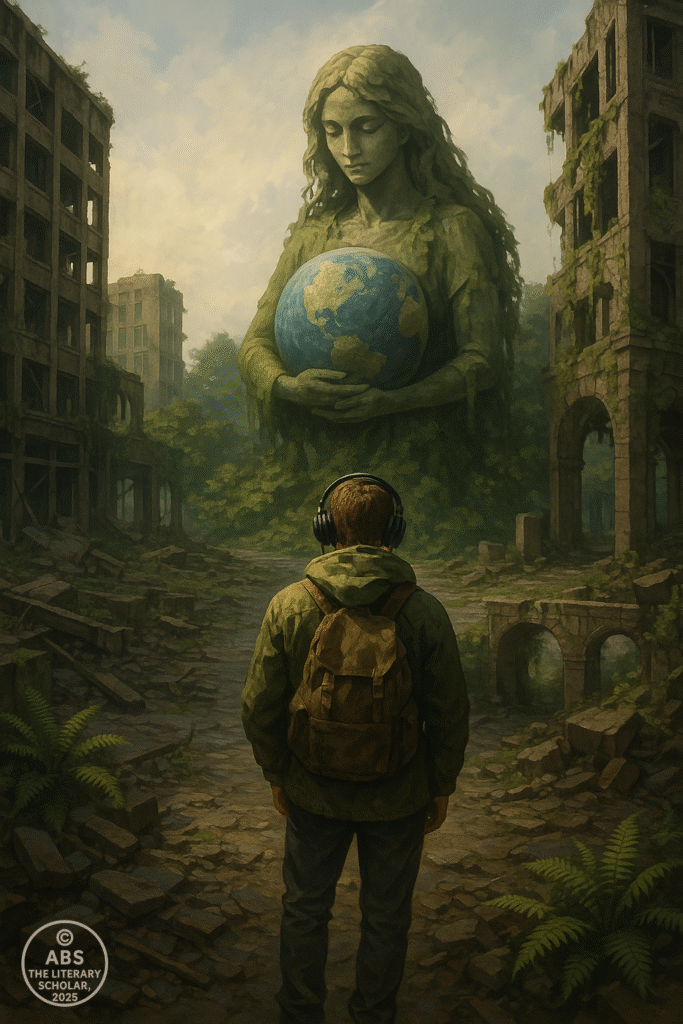
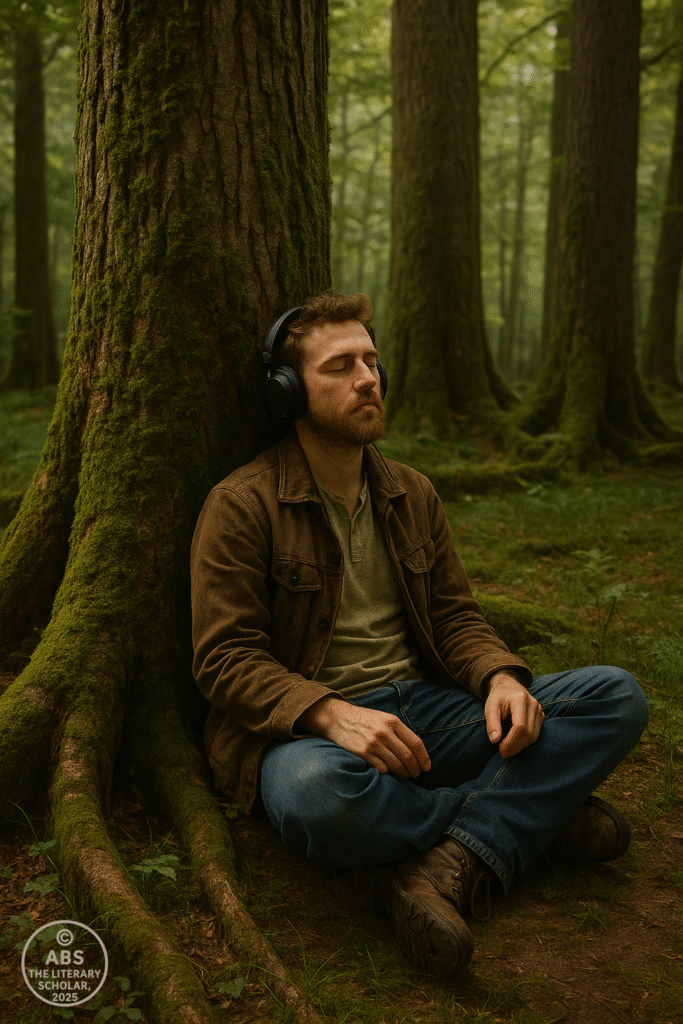
There was a time when literature asked only what it meant to be human.
Today, it must also ask: What does it mean to live among the more-than-human? What responsibilities come with language, when the world itself is unraveling—silently, slowly, syllable by syllable?
Ecocriticism is not simply a theory—it is a way of noticing differently. It reminds us that the poet and the planet have always been in dialogue, even when one was reduced to metaphor.
Now, the metaphors are burning. The rivers we once used to rhyme are rising. And the silence of the earth is no longer silence—it is accumulated grief.
Literary studies must evolve—not as a reaction, but as a renewal.
To read a poem about daffodils today is also to ask where those daffodils bloom, what poisons may touch their roots, and who has access to their spring.
The climate crisis is not just scientific. It is narrative. And literature has always been the conscience of crisis.
We must, therefore, turn our attention not only to what is written in books, but to what is written in the wind, the soil, the shoreline, and the shattered canopy of a forest that once sheltered verse.
As readers, we now carry the burden of dual literacy:
One in words.
And one in wounds.
ABS folds the final page with care, as a dry leaf drifts onto the desk from the open window.
Signed,
ABS, The Literary Professor
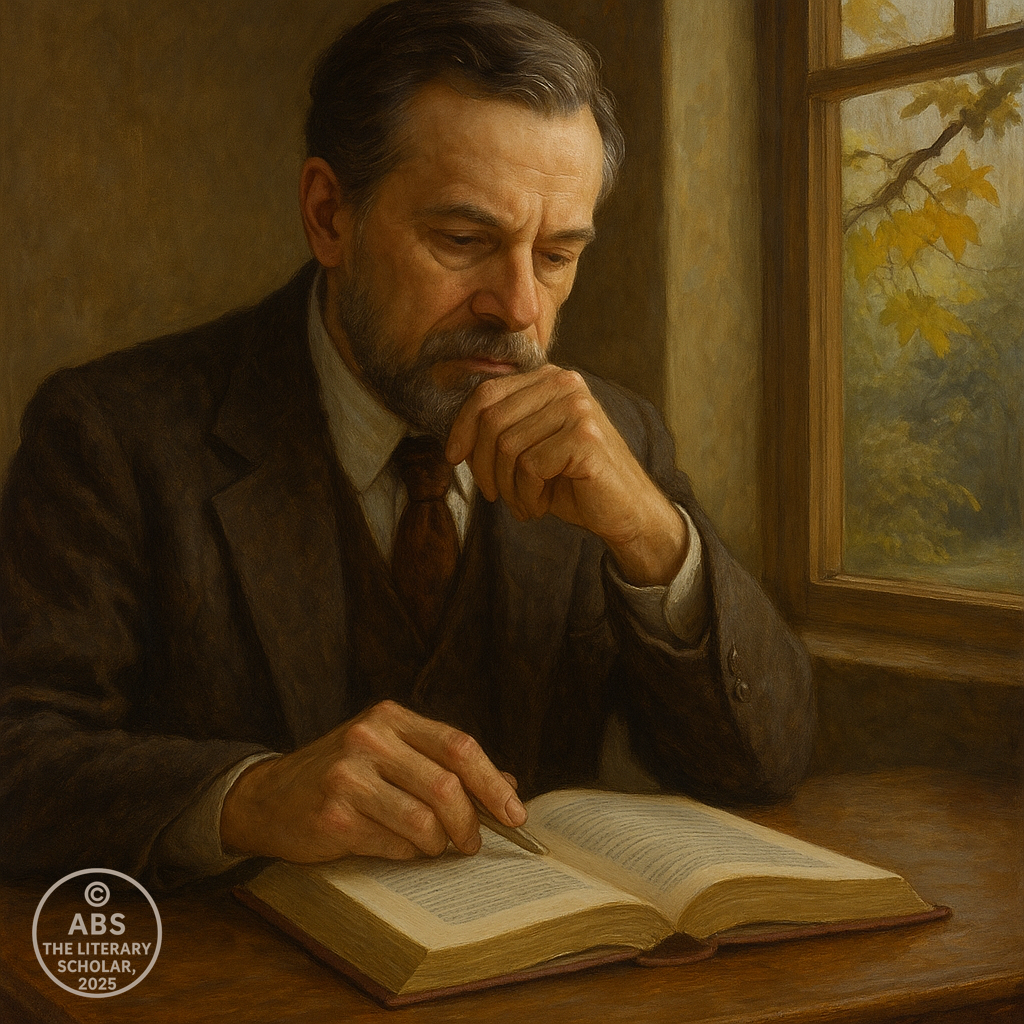
Share this post / Spread the witty word / Let the echo wander / Bookmark the brilliance
